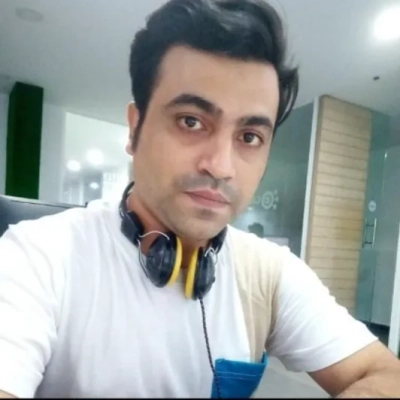13 Insights from Competitor Analysis On Usp Refinement
Unlocking the full potential of a unique selling proposition requires more than just guesswork; it demands a rigorous competitor analysis and strategic refinement. This article distills expert insights on how to analyze and outmaneuver competitors, ensuring your brand not only stands out but resonates powerfully with your audience. Discover actionable strategies that blend innovative technology with human expertise to elevate your business above the fray.
- Analyze Competitors to Define Your Edge
- Provide Personalized Support
- Focus on Customized Solutions
- Blend AI Insights with Human Expertise
- Offer Real-Time Transparency
- Emphasize Brand Storytelling
- Bridge the Gap with Custom Microservices
- Simplify User Experience
- Craft Personalized Strategic Partnerships
- Cater to Corporate Travelers' Needs
- Offer Transparent IT Consulting
- Be Your Growth Partners
- Prioritize Superior Color Accuracy
Analyze Competitors to Define Your Edge
At Rathly, we focus on understanding competitors to help shape our own positioning. I've found that looking at their strengths and weaknesses shows where we can stand out. For example, when we researched what others were offering in the market, we realized they weren't using data-driven insights to their full potential. We honed in on that gap and refined our approach. Now, our USP is all about providing clear, actionable results through proven strategies that work. We don't rely on fluffy promises.
Taking time to analyze what competitors miss lets you define your edge. I've seen this firsthand: by focusing on what we do best-turning data into high-impact marketing campaigns-we've attracted businesses that want results, not theory. Stay focused on what sets you apart and find gaps that others overlook.

Provide Personalized Support
I remember a time when competitor analysis helped us refine our unique selling proposition (USP). We noticed that most of our competitors were offering similar features but lacked personalization in their customer service. This insight led us to emphasize our USP of providing tailored, one-on-one support, where we go the extra mile to understand each customer's needs and offer solutions accordingly.
This differentiation really set us apart. Customers appreciated the personal touch, and it became a key reason they chose us over competitors. It showed that by understanding what others were missing, we could offer something more valuable to our audience.

Focus on Customized Solutions
There was a time when competitor analysis played a crucial role in helping me refine our unique selling proposition (USP). We were in a competitive market, offering a service that many others also provided, but we were struggling to communicate what made us stand out. So, we decided to take a deep dive into what our competitors were offering and how they positioned themselves.
What we discovered was that many of our competitors focused heavily on features—everything from the bells and whistles of their service to their broad claims about "speed" or "reliability." While these are important, they weren't what truly resonated with our audience. Our analysis revealed that customers weren't just looking for more features: they were looking for personalization and support that felt tailored to their specific needs. In other words, they wanted a service that understood their unique situation and could adapt to it, not just one-size-fits-all solutions.
Armed with this insight, we refined our USP to focus on customized solutions with a personal touch, emphasizing that we took the time to truly understand our clients' needs and crafted strategies that worked specifically for them. We positioned ourselves not just as a service provider, but as a trusted partner who would be there to adapt and pivot alongside our clients as they grew.
This shift made all the difference. We were no longer just another option in a crowded market; we were a business that cared about individual client success, with a focus on long-term relationships rather than quick fixes. This became a powerful differentiator, and our clients started responding to our messaging in a more meaningful way. The competitor analysis didn't just show us where we were similar to others; it highlighted where we could be different, and that made all the difference in how we presented ourselves to the world.

Blend AI Insights with Human Expertise
Competitor analysis played a key role when I launched Profit Leap. Many firms were focusing either on AI solutions or traditional consulting. I saw an opportunity where we could blend AI-driven insights with human expertise, providing a unique dual-layered approach to business strategy. This differentiated us, allowing small businesses to leverage both cutting-edge technology and seasoned strategic guidance.
A notable example was our work with a small law firm struggling with customer churn. By incorporating our AI business advisor, Huxley, we provided predictive insights into client behavior. Coupled with personal strategic consultations, we managed to reduce their churn rate by 35% within a year. This combined approach positioned us distinctly in the market, demonstrating the synergy of technology and personalized advice.
My medical background helped too; diagnosing business problems as one would a patient. This perspective allowed me to innovate further in creating our 8 Gears of Success framework, which addresses unique operational challenges, continuously refining our USP and setting us apart from others in a predominantly tech or strategy-focused sector.

Offer Real-Time Transparency
I remember a time when competitor analysis really sharpened our USP at Linear Design. We were examining the landscape of digital marketing firms, particularly those focusing on paid advertising. Most competitors touted just performance metrics, but neglected real-time transparency. Recognizing this, we pivoted to promote our "Predictable Growth with Custom Reports" USP, offering a blend of performance and transparency that set us apart.
One standout case was our work with a global retail client. Competitors offered standard reports with generic insights, but we provided real-time dashboards that clients could tweak. This empowered the client with dynamic insights, dramatically improving their ad spend efficiency and ROI. This fresh approach distinguished us from other agencies by providing real-time, clear, and actionable data, fostering trust and long-term partnerships.
In refining our USP, we heavily invested in understanding competitors' weaknesses—such as lack of adaptability—and turned them into our strengths. By addressing unmet needs like real-time reporting and sustainable growth models, we established a reputation not just for achieving results but for achieving them transparently and predictably, which resonated with many businesses searching for accountability.

Emphasize Brand Storytelling
When I was leading a rebranding initiative at Ankord Media, competitor analysis provided invaluable insights that helped refine our USP. We closely examined the landscape of creative design studios to identify common offerings and gaps in their services. Noticing a lack of strong narrative elements, we positioned Ankord Media as not just a design studio, but as brand storytellers who fuse innovative design with authentic customer connections.
One specific project involved a tech startup aiming for market expansion. By incorporating competitor insights and creative A/B testing, we bridged branding gaps they hadn't addressed, crafting a narrative that spoke directly to their tech-savvy audience. This approach set us apart by not just being visually appealing, but also emotionally engaging and strategically sound. Our ability to translate their vision into compelling stories significantly differentiated us, leading to increased client engagement and satisfaction.
Bridge the Gap with Custom Microservices
During the early days of UpfrontOps, I dug into a comprehensive competitor analysis to sharpen our unique selling proposition. I noticed that while many companies offered either enterprise-level solutions or basic services for SMBs, few bridged this gap effectively. Leveraging this insight, we developed an on-demand microservices marketplace for small businesses alongside elite fractional sales operations for larger firms.
An example of how this worked in practice was when we partnered with an educational technology startup. Instead of offering a one-size-fits-all solution, we provided custom microservices that improved their CRM and lead nurturing strategies. This not only refined their sales pipeline but landed them a $250,000 contract with a major school district, firmly differentiating UpfrontOps from traditional agencies.
In refining our USP, the focus was on flexibility and scalability, enabling small businesses to access tools typically reserved for large enterprises. This helped us maintain a 33% month-over-month organic growth rate, showcasing the tangible benefits of a well-defined and distinctive market position. Competitor analysis has been pivotal for UpfrontOps, especially when identifying market gaps in operational expertise marketplaces. While traditional agencies offered either high-cost comprehensive services or low-value microservices, I identified a niche for scalable, on-demand microservices paired with elite fractional sales operations experts. This hybrid model allowed us to cater to the unique needs of small businesses and enterprise customers, setting us apart.
A specific example is our partnership strategy, where we became an authorized reseller for 4,500+ global B2B tech brands. Analyzing competitors' strongholds and weaknesses showed that many lacked diverse partnership ecosystems. This insight directed us to prioritize extensive partnerships, which in turn fueled our 33% month-over-month organic growth.
Having also dug into industries like telecom, education, and finance, I learned the importance of flexible solutions. Our educational tech startup story aligns with this: securing a $250,000 contract by pinpointing client needs in tech for education, tapping into an underserved market—something overlooked by purely tech-focused firms.

Simplify User Experience
I noticed competitors were packing in features, but users were frustrated by the complexity. By focusing on reviews, it was clear people wanted simplicity, not bloat.
We doubled down on making things intuitive and frustration-free, and that became our edge. Customers loved having a tool that just worked without the hassle.

Craft Personalized Strategic Partnerships
Early in SuperDupr's journey, I conducted competitor analysis that revealed a gap in the market for businesses seeking not just digital solutions but strategic partnerships. We found competitors often focused narrowly on tech solutions without the broader strategic context. We incorporated this insight into our USP by emphasizing our ability to craft personalized, strategic partnerships with a focus on both immediate digital needs and long-term growth.
A specific case was our work with Goodnight Law, a client needing both technical support and strategic advice on conversion optimization. While competitors were recommending standard redesigns, our approach was to integrate seamless automated follow-ups with updated visual designs. This strategy not only resolved their existing technical issues but also drove higher conversions, setting us apart by showcasing the deeper, value-driven partnership we offer clients. By differentiating ourselves through this comprehensive and custom approach, we've been able to save time and money for our clients, proving the efficacy of our model. A pivotal moment of competitor analysis came when evaluating the digital solutions landscape to refine SuperDupr's USP. While competitors heavily focused on either strategy or implementation, I noticed a gap in seamlessly integrating AI-driven automation with swift project launches. This insight led us to highlight our "Save Time and Money, Launch Quickly" USP, setting us apart by offering comprehensive digital solutions that improve operational efficiency.
For instance, our collaboration with The Unmooring demonstrated this USP in action. They needed not only a website overhaul but also a strategy for repeat customer engagement. By focusing on automation and quick implementation, we converted their outdated website into a high-converting platform. This approach drove significant client retention and satisfaction, differentiating SuperDupr from other agencies that couldn't execute with the same speed and efficiency.

Cater to Corporate Travelers' Needs
In the early days of Detroit Furnished Rentals, I closely analyzed competitors to refine our unique selling proposition. Many rentals were focusing on either luxury or budget options, so I saw an opportunity to cater to corporate travelers by offering fully equipped kitchens and dedicated workspaces, which were largely absent in other listings. This allowed us to stand out in a saturated market by meeting the specific needs of professionals and working travelers.
To further differentiate, we focused on being pet-friendly, which we found was a gap in the market through competitor reviews. We provided accommodations that cater to guests traveling with pets, which led to a higher satisfaction rate and increased bookings. This strategic differentiation not only set us apart but also established a loyal client base that values these custom features.
Our competitor analysis also highlighted the lack of personalized local experiences offered by others, prompting us to curate area guides and establish partnerships with local businesses. This provided guests with a holistic experience, emphasizing both comfort and engagement with Detroit's cultural scene, effectively solidifying our place in the market.

Offer Transparent IT Consulting
Our expertise at ETTE lies in IT consulting, specifically for non-profits and small businesses. A standout moment of competitor analysis reshaping our USP was identifying gaps in competitor service transparency. Many offered support without explaining the depth of services covered, causing confusion.
We crafted a transparent, per-user pricing model that clearly outlines our offerings—a move that resonated with budget-conscious clients. Our case study with a local non-profit, struggling with unpredictable IT costs, showcased our model leading to a 30% reduction in their annual IT expenditure. By emphasizing clarity and predictability, we offer a relief other firms often miss, forging trust and long-term engagement.

Be Your Growth Partners
A couple of years ago, we faced a challenge familiar to many—standing out in an oversaturated market of web development services. Our offerings were solid, but when clients asked, "Why should we choose you over others?" our answers felt generic. That's when we turned to competitor analysis, and the insights we gained transformed our positioning.
We didn't just browse websites or compare pricing. We analyzed competitors' customer reviews, social media interactions, and even case studies to understand their strengths and gaps. A recurring theme emerged: most competitors highlighted speed and cost-efficiency as their key selling points. While impressive, we noticed something critical—they weren't emphasizing long-term relationships or personalized solutions.
This observation became the cornerstone of our unique selling proposition (USP): "We're not just developers; we're your growth partners." Instead of promoting speed, we emphasized our consultative approach—working closely with clients to craft tailor-made solutions, offering strategic input, and ensuring ongoing support. To reinforce this, we revamped our branding, using real client stories and metrics that showcased measurable growth achieved through collaboration.
The result? We didn't just differentiate ourselves—we began attracting businesses that wanted a partner, not just a service provider. Our retention rates improved, and word-of-mouth referrals skyrocketed.
Tips
Dig deeper in competitor analysis: Look beyond what competitors say they offer and focus on what they don't.
Find your audience's unmet needs: Align your USP with those gaps to create a value-driven proposition that resonates.

Prioritize Superior Color Accuracy
Conducting competitor analysis led me to refine Prints Giclee Shop's USP by focusing on superior color accuracy and personalized client attention. While other print shops offered generic services, I prioritized an in-person proofing process, ensuring clients could see and perfect color accuracy before final printing. This hands-on approach attracted galleries needing precise reproductions, differentiating us in the Miami art market.
An example of this was when I observed competitors emphasizing speed over quality. I went the opposite route by showcasing our commitment to craftsmanship and customization. Our investment in this quality-centric USP not only increased client satisfaction but also led to repeat business from a renowned local gallery that appreciated our dedication to detail. This focus on quality and personal connection has become our hallmark, setting us apart in a competitive space. Analyzing competitors is critical in carving out our niche in Miami's fine art printing market. When I assessed local and national print shops, I noticed a common trend: many lacked a personalized approach, especially when it came to artist consultations and proofing sessions. By offering in-person proofing and consultations, my Prints Giclee Shop stood out, appealing to artists who value bespoke service and color accuracy.
One specific insight came from observing competitor websites, where eco-friendly options were scarcely mentioned. I decided to incorporate sustainable printing materials like Hahnemuhle's Natural Line papers into our core offerings. This drew in environmentally-conscious clients, boosting eco-print orders by 15%.
These competitor analyses helped refine our unique selling proposition as a service-focused, environmentally-aware print shop. This approach fine-tuned our brand identity, driving increased loyalty and attracting clients who share our values.



